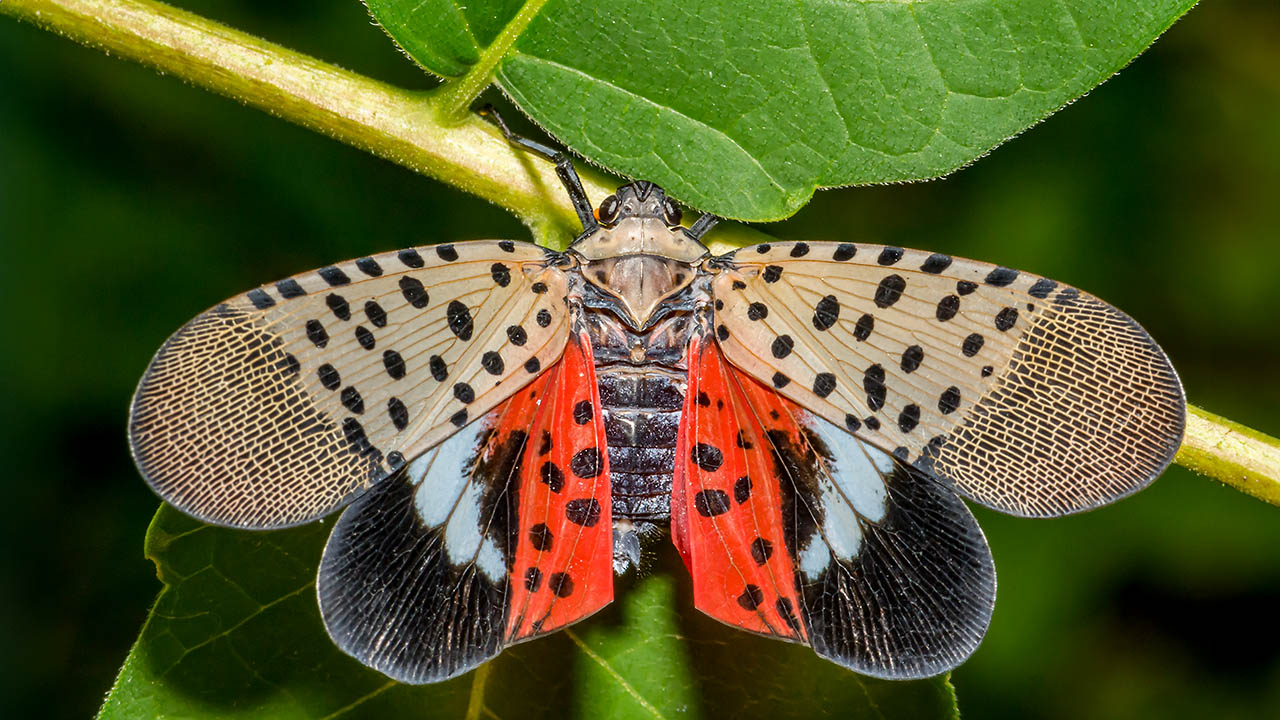Spotted Lanternfly Spotted in Weston

ondreicka/Adobe Stock
An invasive insect now known to be present in Weston is so worrisome to the U.S. Department of Agriculture that the agency asks that if you see one, squash it.
The admittedly striking Spotted Lanternfly (Lycorma delicatula) was reported this week to be present on Ailanthus trees on Weston Road by Master Gardener Christina Koether. The insects, not always as colorful as in the photo at the top of the page, look different at different stages of life. The red is only visible when wings are spread.

In the photo above, from left to right: an immature Spotted Lanternfly, a mature one with wings spread, another mature one as commonly seen, and a glop of lanternfly eggs. USDA photos.
Ms. Koether’s discovery was not exactly a surprise. The Ailanthus tree, also known as the Tree of Heaven, is also an invasive and is the preferred feeding venue for juvenile and adult spotted lanternflys. But, according to the USDA, the insects also feed on “a wide range of crops and plants, including grapes, apples, hops, walnuts and hardwood trees.” In January, a concerned state agency issued a quarantine order.

Ailanthus altissima, the Tree of Heaven. Riccardo Arata/Adobe Stock
The discovery was also likely not a surprise for Tree Warden Tom Failla, who says he identified a Spotted Lanternfly late last year on Weston Road (Route 57) near the Westport town line, destroyed it, and notified a nearby plant nursery and the Town Administrator. Until this month, said Dr. Failla, no other lanternflys have been reported in Weston.
The concern
The Spotted Lanternfly is no threat to humans, but according to the Department of Energy and Environmental Protection (DEEP), it is a serious threat to trees and fruit.
The department estimates that 47 percent of Connecticut’s forest trees are vulnerable to the lanternfly, as are many fruit trees, including apples, cherries, grapes, and peaches. The insect may or may not kill the trees, but even if they survive, the fruit could effectively be destroyed. “The impact on the agricultural industry of Connecticut could be devastating,” according to DEEP.
DEEP officials acknowledge that the impact of the Spotted Lanternfly — often referred to in documents as the SLF — is uncertain, may turn out to be “an annoyance,” but has the potential to cause “much more significant damage.”
Lanternflys feed by sucking sap from the stems and leaves of host plants, which can reduce photosynthesis and weaken the plant. The feeding produces a sticky residue called honeydew that attracts other insects and promotes mold, which can also block photosynthesis. The honeydew, according to DEEP, is hard to remove, which can destroy the value of a farmer’s crop.
What to do
Dr. Failla, who plans to report to the Board of Selectmen in September with recommendations, has these recommendations for anyone who identifies a Spotted Lanternfly:
- Don’t move wood or potentially infested material from the site. These insects spread very easily.
- Take a picture of the insect and report the sighting. An online reporting form can be found here.
- Kill it.
- When traveling through an area known or suspected to have a lanternfly population, check your vehicles (cars, trucks, trailers) for stowaways. SLFs are know to “hitch a ride” on vehicles and even clothing.
Resources
Additional information from the U.S. Department of Agriculture.
Additional information from the Connecticut Department of Energy and Environmental Protection.
A guide for identifying the Spotted Lanternfly — and lookalikes — from the USDA.

Scenic Corner/Adobe Stock
